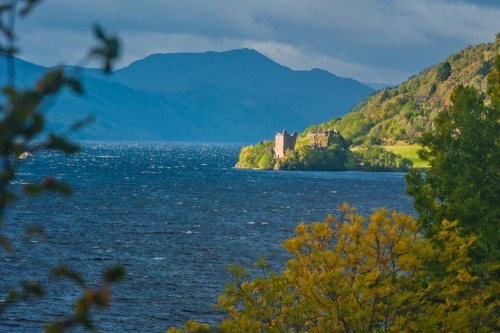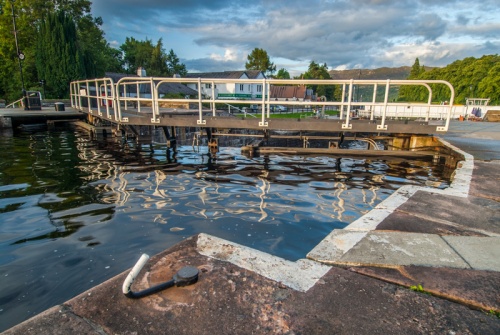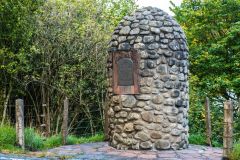
Loch Ness stretches 23 miles southwest from Inverness to Fort Augustus and the Caledonian Canal that connects it to Loch Oich. The loch is famous as the alleged home of the Loch Ness Monster, usually dubbed 'Nessie', a serpentine creature of dubious origin and even more dubious reality!
The Loch is forested along both shores sides and there are a large number of signposted walking trails. On the northwest bank is historic Urquhart Castle, the biggest tourist attraction in the area.

'Nessie' the Loch Ness Monster
It is hard to hear the words 'Loch Ness' and not think of the mythical Monster, but tales of a strange creature in the depths of the loch are a fairly recent bit of folklore. Tales of lake monsters are told all across Scotland, though the exact form of those monsters varies from place to place.
The first written record of a monster sighting is in a 7th-century record of the life of St Columba, though in this case the monster was discovered in the River Ness, not the loch. It was not until 1933 that the first reported sighting of a monster came to public attention.
This was followed by a famous photograph published in 1934 showing a long-necked creature swimming in the loch, looking very much like a prehistoric plesiosaur. This so-called "Surgeon's Photograph" has since been proven to be a hoax, but once the public imagination was captured by the photo, more sightings were reported, and attempts were made to rigorously examine the reports and find proof of the Monster's existence.

Loch Ness Centre
Not far from Urquhart Castle is the Loch Ness Centre, housing an exhibition on the Monster and attempts to discover what, if anything, lurks in the dark waters of the loch. See underwater craft and sonar equipment used to search for the Monster, and examine old photographs and accounts of encounters so you can decide for yourself if the Monster is real or not.
Author's Note:
Our family visited Loch Ness for a week, staying near the Falls of Foyers. Our daughter, then six, swears she saw Nessie in the loch, though her imagination may have been fired by a cuddly Monster toy we purchased for her at a gift shop in Fort Augustus, complete with a tartan cap.
Urquhart Castle
Roughly halfway along the loch at Drumnadrochit, hugging a promontory on the western shore, is this picturesque castle, begun in the 13th century. The first written record comes from 1296 when Edward I of England captured it and installed a garrison. The English were driven out, recaptured the castle, and were driven out again. Robert Bruce captured Urquhart in 1307, and from this point the castle was held by the crown.
The castle was attacked multiple times by the MacDonald Lords of the Isles, then in 1509 James IV granted it to Clan Grant, on condition they repair and maintain it. Maintaining it proved the hard part, for the MacDonalds and Grants fought over the castle on numerous occasions. It was left to decay in the mid-17th century, then destroyed in 1692 to prevent it being used by the Jacobites. The most striking remain is Grant Tower, standing five storeys high.

Drumnadrochit village grew up at the point where two rivers flow into Loch Ness. It is worth exploring the village and strolling over Thomas Telford's bridge across the River Enrick to the Loch Ness Centre and Exhibition.
The Centre explores the fascinating history of the loch and the legend of the Loch Ness Monster through state-of-the-art multi-media displays. See submarines used in the search for the Monster and learn how the unique eco-system of the loch makes the story of a creature living in the loch's depths plausible.
Just outside Drumnadrochit is Divach Falls, a lovely 100-foot-high waterfall reached via a trail through attractive oak woodland. In the Victorian period, before the legend of the Loch Ness Monster became so widespread, a trip to Divach Falls was the main reason to visit Drumnadrochit.
If you take the A831 west from Drumnadrochit and branch off onto a minor road just before you reach Cannich you will come to the Corrimony Chambered Cairn, a beautifully-preserved Bronze Age passage grave in an idyllic rural location in Glen Urquhart, surrounded by 11 standing stones. You can access the inner burial chamber where archaeologists found a single burial during excavations in 1954.
If you continue on past the road to Corrimony Cairn you will come to Glen Affric, perhaps the most beautiful glen in the Highlands. Much of the glen is owned by Forestry Commission Scotland and they Commission operates four car parks for visitors. Two of these car parks give access to dramatic waterfalls including Dog Falls and Plodda Falls. The glen is criss-crossed with a network of walking trails, giving access to 8 Munros (peaks over 3,000 feet).

Just south of Drumnadrochit and Urquhart Castle is the John Cobb Memorial, commemorating the man who died on Loch Ness in an attempt to break the water speed record in 1952. Cobb's attempt took place in Urquhart Bay, just below the cairn.
Invermoriston
Between Fort Augustus and Drumnadrochit is Invermoriston, a pretty village that grew up at the point where the River Moriston spills into Loch Ness. The modern road bridge across the river replaced a picturesque humpbacked bridge designed by Thomas Telford in the early 19th century.
Telford's bridge looks over the lovely Falls of Moriston. Near the bridge is St Columba's Holy Well, thought to have healing properties. The Well may date to the 6th century, when St Columba journeyed through the Great Glen to convert the Picts to Christianity.

Fort Augustus
The gateway to Loch Ness from the west, Fort Augustus grew up around a military fort established by General Wade in the aftermath of the First Jacobite Rebellion in 1715. Fort Augustus is the eastern terminus of the Caledonian Canal, reached by a series of locks connecting Loch Oich to Loch Ness.
It is a popular pastime to sit by the canal and watch boats go through the locks. The major focus is tourism, with a plethora of gift shops and tourism facilities, much of it geared around the legend of the Loch Ness Monster.
One of the most popular gift shops also doubles as the Fort Augustus Clansman Centre, an interactive museum where you can see live demonstrations by costumed actors dressed in traditional Highland garb, showing what life was like in the 18th century in the Scottish Highlands. The Clansman Centre is housed in a historic Victorian schoolhouse.

On the edge of Fort Augustus is a Forestry Commission Scotland parking area and a woodland trail leading to a waterfall on Allt na Criche burn. The waterfall trail offers spectacular views over Loch Ness and the village of Fort Augustus itself as well as a birds-eye view of Cherry Island, a manmade crannog, the only 'island' on Loch Ness.
Falls of Foyers
On the rarely explored south-east shore of the loch is a stand of parkland surrounding the Falls of Foyers. The Gaelic name for the falls is 'Eas na Smuide', which translates as smoking falls, a reference to the clouds of mist thrown up by the thundering water as it tumbles 165 feet into a pool. Trails lead through attractive woodland to a viewing area looking towards the falls.
Near Foyers is Whitebridge, named for a picturesque 18th-century bridge built by General George Wade, who served as Commander in Chief of the British army in North Britain and built over 240 miles of roads and 40 bridges across the Highlands from 1724-1740.

Bridge of Oich
Just a few miles south of the loch is the historic Bridge of Oich, a suspension bridge across the River Oich built by James Dredge in 1854 after a disastrous flood had swept away the previous bridge. Dredge's innovative design used a unique double cantilever chain support system, essentially creating a bridge in two halves, each half of which could stand on its own should the other half be destroyed.
Inverness
If instead of going south from the loch you head north, you will come to historic Inverness, which grew up around the point where the River Ness empties into the Moray Firth. Inverness is the capital of the Highlands and boasts a super Victorian Cathedral and a castle built on the site of a medieval fortress overlooking the river.
Take time to explore the Victorian market and learn about the rich history of the region in the Inverness Museum, complete with an exhibit on Jacobite history that includes items linked with Bonnie Prince Charlie.
Just outside Inverness is Culloden Battlefield, where Bonnie Prince Charlie's dream of seizing the united throne of England and Scotland died in 1746. A mile from the battlefield is Clava Cairns, an extraordinary prehistoric site that helped inspire the popular Outlander books and TV series. Beyond Clava Cairns is Fort George, built to help the Hanoverian King George II defend his crown from the Jacobite threat.
About Loch Ness
Address: Highlands,
Highland,
Scotland
Attraction Type: Countryside - Lake
Location: On the A82 between Inverness and Fort William; the B862/852 (narrow with passing places) runs along the less traveled side of the Loch
Location map
OS: NH528 296
Photo Credit: David Ross and Britain Express
Opening Details: Open access site, usually accessible at any reasonable time
HERITAGE
 We've 'tagged' this attraction information to help you find related historic attractions and learn more about major time periods mentioned.
We've 'tagged' this attraction information to help you find related historic attractions and learn more about major time periods mentioned.
Historic Time Periods:
Find other attractions tagged with:
13th century (Time Period) - 17th century (Time Period) - 18th century (Time Period) - 19th century (Time Period) - 6th century (Time Period) - 7th century (Time Period) - Bonnie Prince Charlie (Person) - Bronze Age (Architecture) - burial chamber (Historical Reference) - castle (Architecture) - Edward I (Person) - George II (Person) - holy well (Historical Reference) - Jacobite (Historical Reference) - Medieval (Time Period) - Picts (Historical Reference) - Prehistoric (Time Period) - St Columba (Person) - Thomas Telford (Person) - Victorian (Time Period) -
NEARBY HISTORIC ATTRACTIONS
Heritage Rated from 1- 5 (low to exceptional) on historic interest
Urquhart Castle - 0.7 miles (Castle) ![]()
Loch Ness Centre - 1.3 miles (Museum) ![]()
John Cobb Memorial - 1.8 miles (Historic Building) ![]()
Divach Falls - 2.5 miles (Countryside) ![]()
Falls of Foyers - 6.1 miles (Countryside) ![]()
Dochfour House & Gardens - 7.6 miles (Garden) ![]()
Corrimony Chambered Cairn - 9 miles (Prehistoric Site) ![]()
Wade's Bridge - 9.2 miles (Historic Building) ![]()
Nearest Holiday Cottages to Loch Ness:
Nearby accommodation is calculated 'as the crow flies' from Loch Ness. 'Nearest' may involve a long drive up and down glens or, if you are near the coast, may include a ferry ride! Please check the property map to make sure the location is right for you.
Inverness, Highlands and Islands
Sleeps: 6
Stay from: £425 - 728
Drumnadrochit, Highlands and Islands
Sleeps: 4
Stay from: £264 - 888
More self catering near Loch Ness













